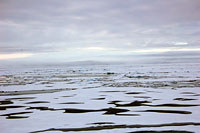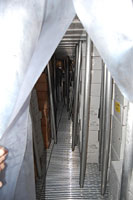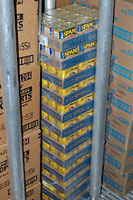

 | |||||||||||||||||||||||||
|
|
Journals 2009/2010Jonathan Pazol
August 20, 2009 Well, our "Polar Bear Drill" of the other day paid off. Once again we heard the announcement over the "pipes" that a polar bear had been spotted off the port (left) side of the ship. People grabbed their coats, cameras, and binoculars and went out for a look. Everyone moved much slower this time - we've already been victims of the "boy who cried 'polar bear.'" The report was that a bear and its cub were several miles off stalking a seal. We looked intensely, and then finally someone spotted them. I was able to zoom in with my video camera and see them, but they appeared very small in the view finder. Once someone lent me binoculars, I could see them more clearly. The mother and cub, which was almost as large, were moving along the ice toward a seal. Before they could reach it, the seal slipped into the water. (According to experts, polar bears are successful at catching seals only 2-3% of the time). Even from the distance, seeing them in the wild was an amazing experience.
I've spent the past several days describing some of the steps in the mapping process, so I wanted to take a little break and focus more on life on the ship. Probably the most common question I was asked before leaving was, "What's the food going to be like?" Actually, it's pretty good, and there's a lot of it. I got a tour of the "mess" and the "galley" and the "dry stores" and the "reefers," so over the next day or two I will describe how they feed us. Food service aboard the Healy is a huge operation. Menus are planned on an 8-week rotation for four meals a day. Food is ordered months in advance to be loaded on the ship before its departure. In the case of this expedition, more than $300,000 of food was brought aboard in Seattle. That included dry foods, fresh fruit, vegetables, dairy products, eggs, etc. In the case of fresh food, anytime the ship docked or had a transport, more food was brought aboard. For our leg of the expedition, the C-130 transport plane delivered a shipment up to Barrow, and we traveled with it aboard the landing craft when we sailed out to meet the Healy.
Non-perishable dry foods, like flour, rice, peanut butter, and yes, even Spam®(r), are stored in racks in a huge area called the "dry store." Fruit, vegetables, meat, and other frozen foods are kept in equally large chilled areas called "reefers" - short for refrigerator/freezers. I knew these areas would have to be big in order to store food for more than 130 people, but the scale was enormous. Rows of racks went back to both sides of the ship and were filled with food.
I couldn't believe how much food there was - the ship was to be away from port for about 13 weeks, and there were several places earlier in the trip to re-supply. It seemed like way too much food. FSCS (Food Service Chief Senior) Marcus Sandifer explained that, indeed, there was actually more food here than needed. Because the Healy sails in the Arctic, it has to be stocked with extra provisions, in case it gets trapped in the ice and can't escape. Consequently, there is enough food (not fresh, of course) for the ship to be at sea for a year. This is a situation I hadn't really thought of before.
|
||||||||||||||||||||||||






